Terrace gardening is easier than you think! You can grow fresh veggies on a small space with the right ideas.
Choose containers like pots or boxes, and pick plants that need less sun. Make sure they get enough light and water.
Grow tomatoes, peppers, or lettuce on your terrace!
Use lightweight soil and check plants daily. Good tips make gardening fun and simple. Start today and enjoy your own green space.
Assess Your Space
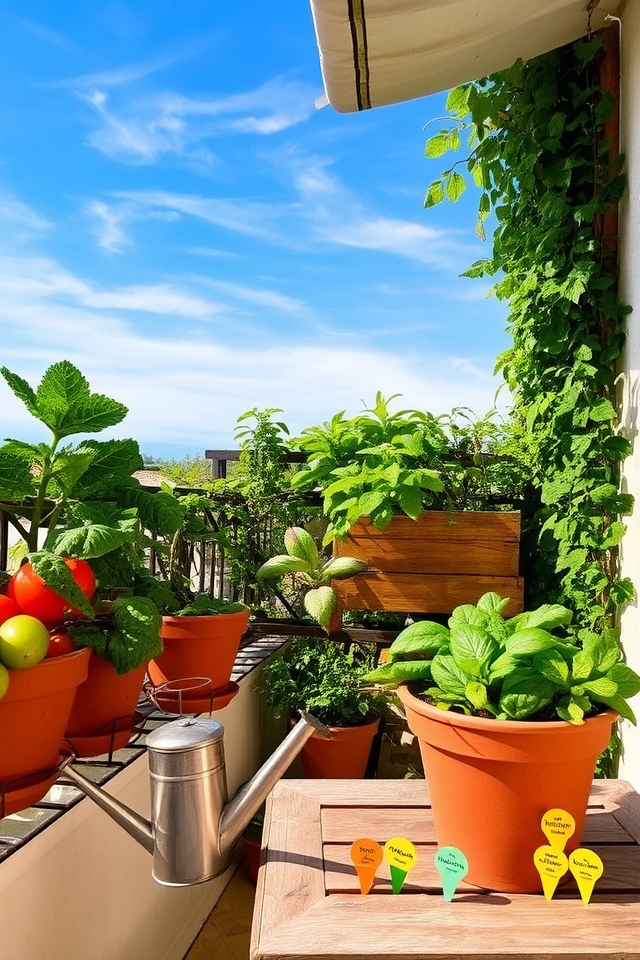
Before you start your terrace vegetable garden, it’s essential to assess your space. Consider factors such as the amount of sunlight your terrace receives throughout the day, as most vegetables thrive in 6 to 8 hours of direct sunlight. Evaluate the wind exposure, as strong gusts can damage delicate plants. Additionally, check for access to water sources, and consider the weight capacity of your terrace to guarantee it can support pots, soil, and planted vegetables.
Choose the Right Containers
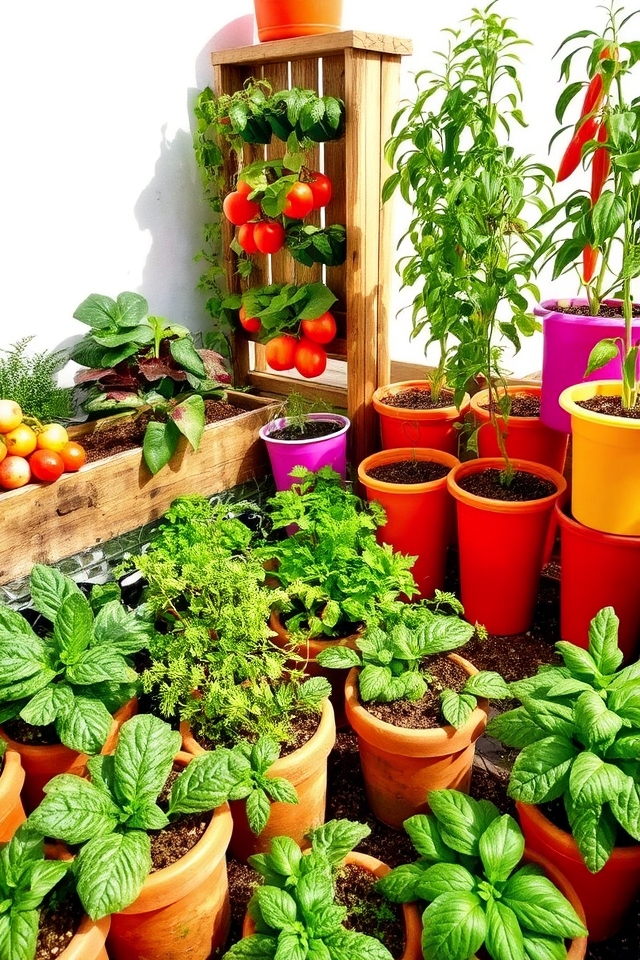
Selecting the right containers for your terrace vegetable garden is essential for healthy plant growth. Opt for containers made from materials like clay, wood, or high-quality plastic, which provide good drainage and insulation. Make certain they are large enough to accommodate root systems and allow for air circulation. Utilize pots with drainage holes to prevent waterlogging, and consider vertical options to maximize space. Remember to choose various sizes to cultivate a diverse range of vegetables effectively.
Select Appropriate Soil
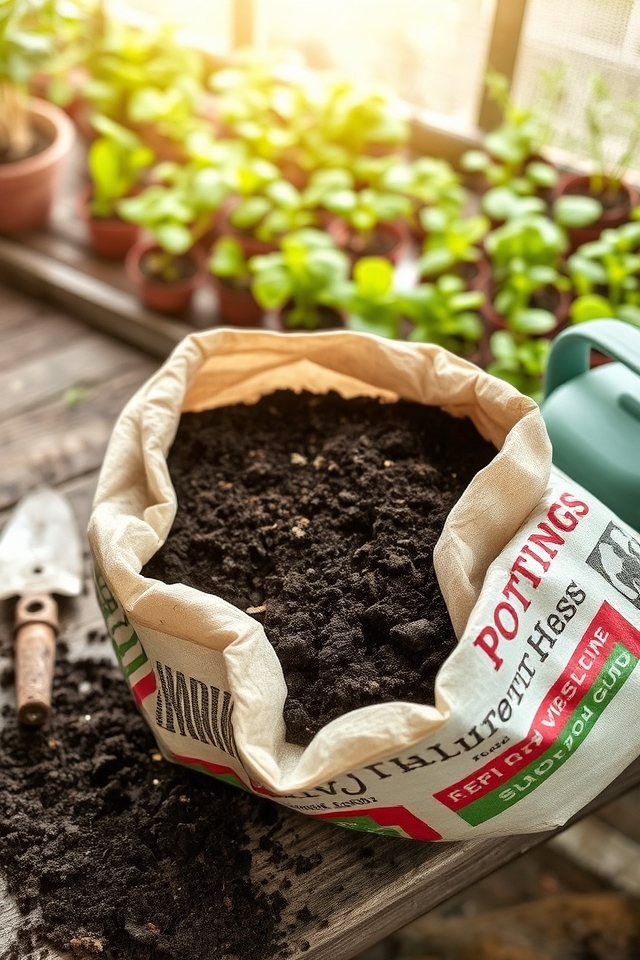
Selecting appropriate soil for your terrace vegetable garden is vital for healthy plant growth. Choose a high-quality potting mix designed for container gardening, as it guarantees proper drainage and aeration. Look for a mix that contains organic matter, such as compost or peat moss, which helps retain moisture and provides essential nutrients. Additionally, consider adding perlite or vermiculite to improve soil structure, assuring your vegetables thrive in their elevated environment.
Plan Your Layout
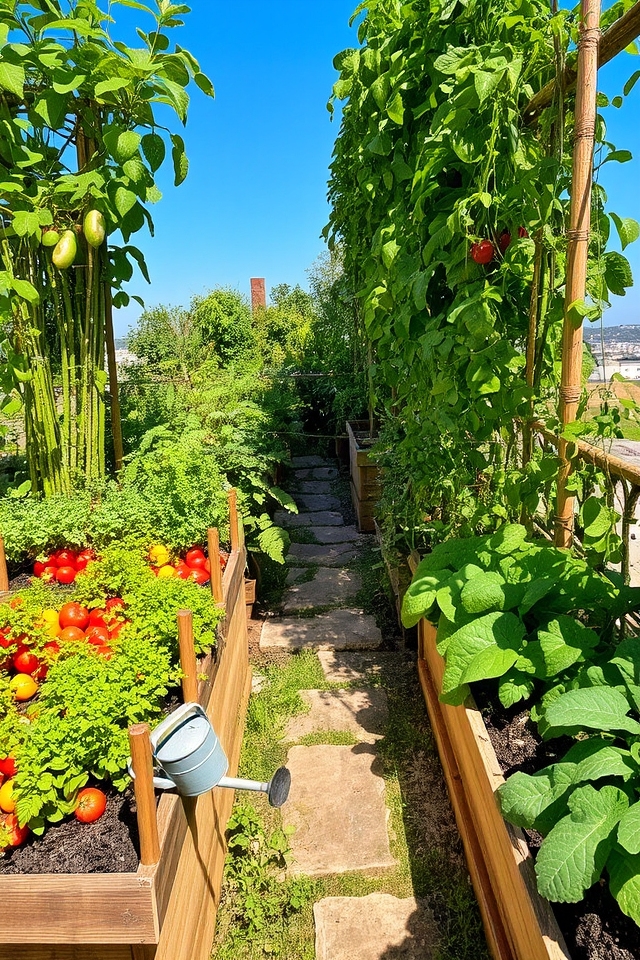
When planning the layout for your terrace vegetable garden, consider sunlight exposure, access to water, and ease of maintenance. Optimize space by using vertical gardening techniques, such as trellises or wall planters, to maximize growing area. Group plants with similar water and sunlight needs together, and guarantee pathways are wide enough for easy access. Sketching your layout in advance can help visualize the arrangement and make adjustments before planting, guaranteeing a productive and efficient garden.
Maximize Sunlight Exposure
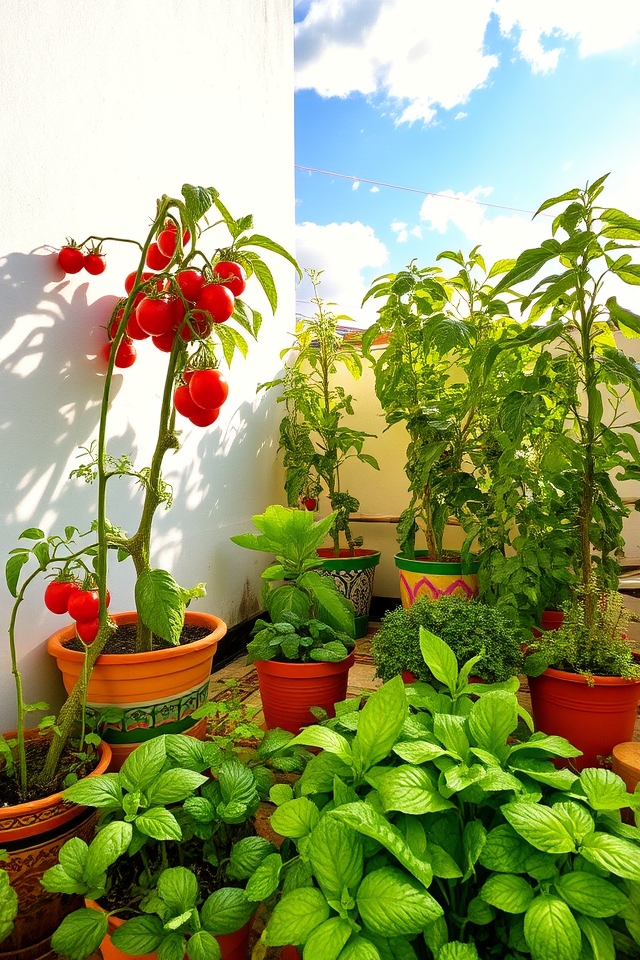
Maximizing sunlight exposure is essential for a thriving terrace vegetable garden. Position larger plants, like tomatoes or sunflowers, on the north side to prevent shading smaller plants. Utilize reflective surfaces, such as white walls or mirrors, to enhance light distribution. Consider using containerized plants that can be easily moved to catch the sun at different times of the year. Regularly monitor sunlight patterns to guarantee all plants receive adequate light for peak growth.
Consider Vertical Gardening
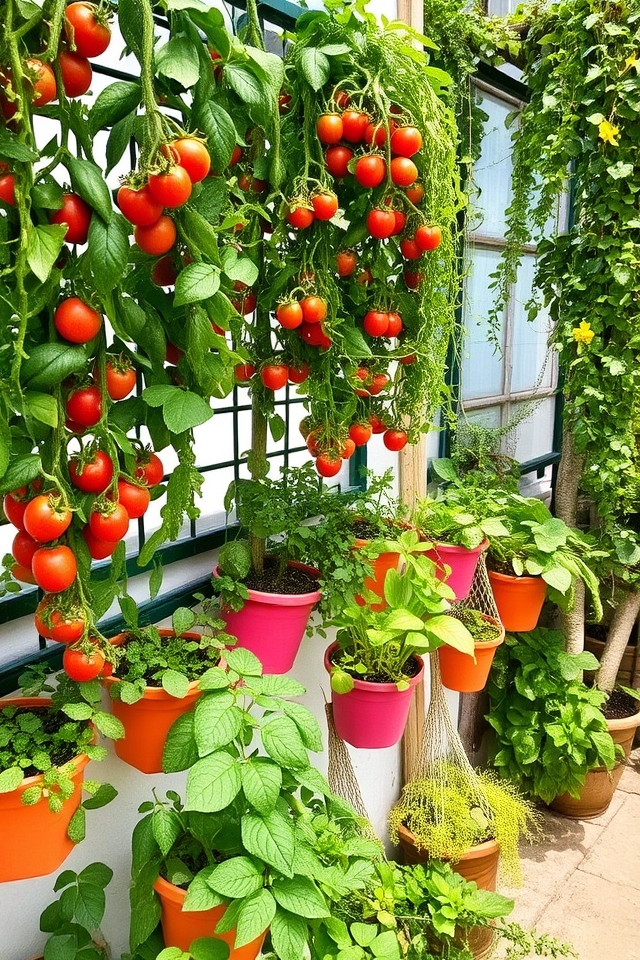
Vertical gardening is an excellent solution for maximizing space in a terrace vegetable garden. By utilizing trellises, wall planters, and hanging pots, you can grow a variety of vegetables like tomatoes, cucumbers, and herbs in a compact area. This method not only saves space but also improves air circulation and sun exposure for your plants. Additionally, vertical gardens can be visually appealing, transforming your terrace into a lush green retreat.
Use Companion Planting
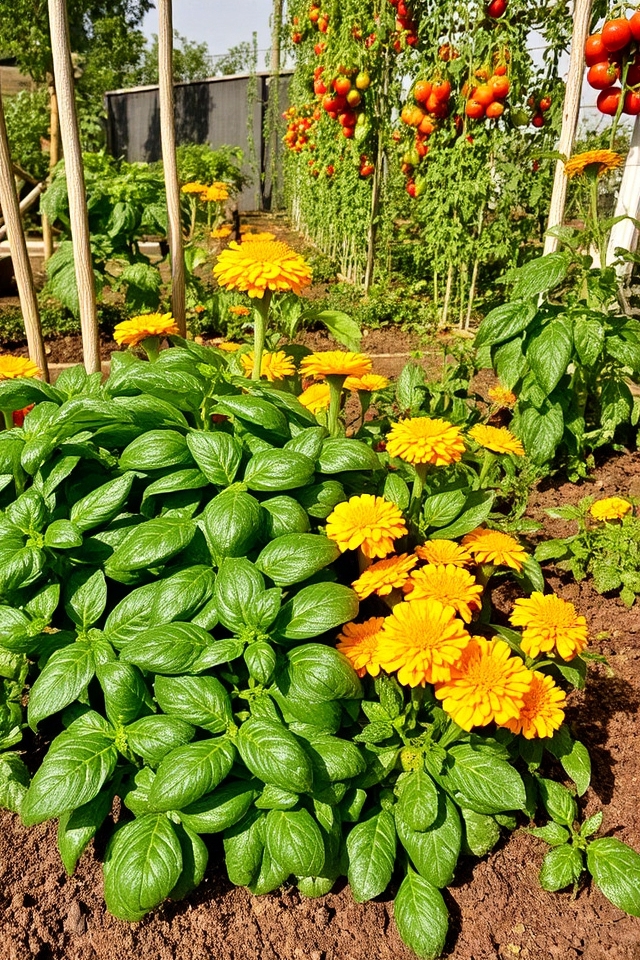
Companion planting involves pairing certain plants together to enhance growth and deter pests. In a terrace vegetable garden, consider planting marigolds with tomatoes to repel nematodes, or basil with peppers to improve flavor. This natural method can enhance nutrient uptake and promote healthy growth while reducing the need for chemical pesticides. By strategically placing compatible plants in close proximity, you create a thriving ecosystem that benefits all species involved.
Start With Easy-To-Grow Vegetables
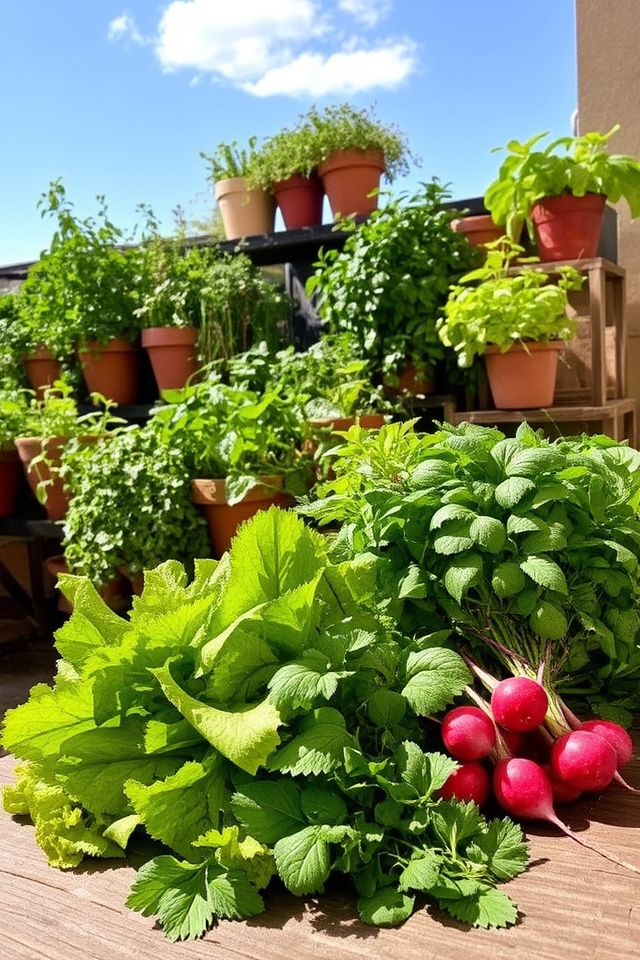
Starting your terrace vegetable garden with easy-to-grow vegetables can boost your confidence and guarantee a bountiful harvest. Consider planting fast-growing options like lettuce, radishes, and herbs such as basil and parsley. These vegetables require minimal maintenance and can thrive in smaller containers, making them perfect for terrace gardening. As you gain experience, you can gradually experiment with more challenging varieties, transforming your outdoor space into a vibrant urban garden.
Ensure Proper Watering Techniques
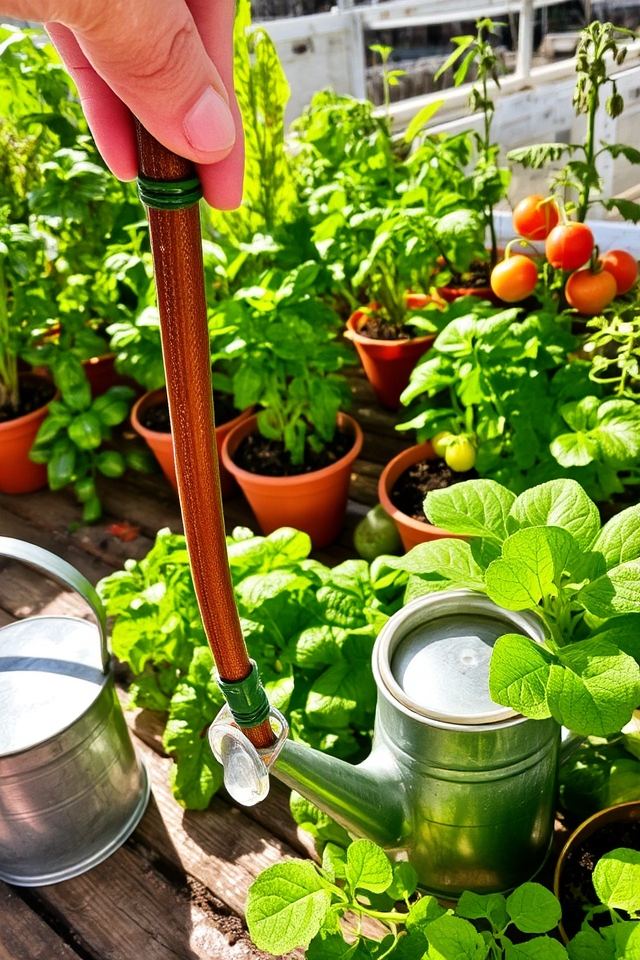
Proper watering techniques are crucial for the success of your terrace vegetable garden. Make certain your plants receive consistent moisture, but avoid overwatering, which can lead to root rot. Early morning is the best time to water, as it allows plants to absorb moisture before the day’s heat. Use drip irrigation or soaker hoses to direct water to the soil, minimizing evaporation. Remember to check soil moisture regularly, adjusting your watering schedule based on weather conditions and plant needs.
Implement Drainage Solutions
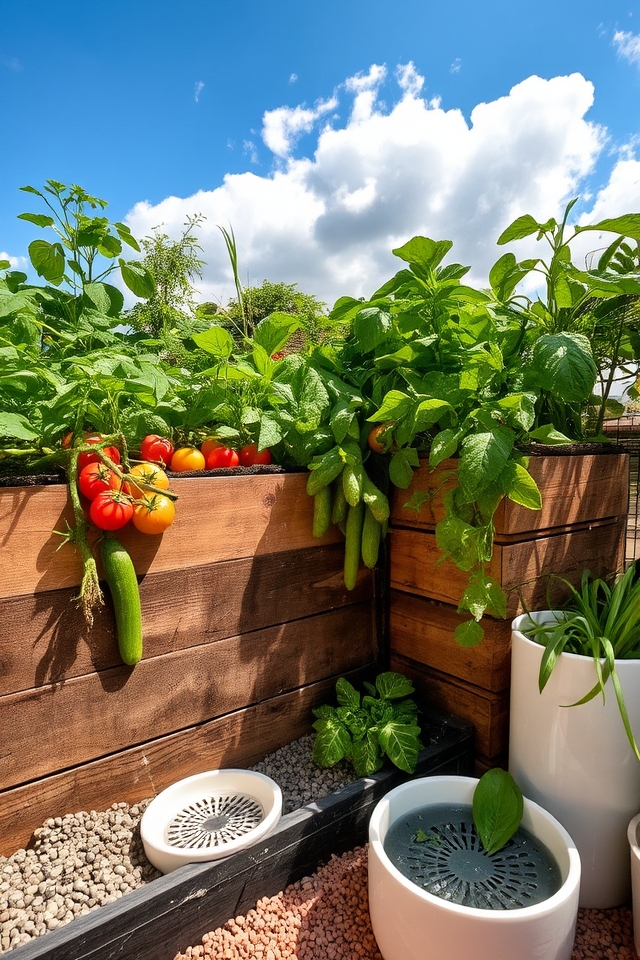
Implementing effective drainage solutions is essential for a thriving terrace vegetable garden. Without proper drainage, excess water can accumulate, leading to root rot and other moisture-related issues. To guarantee adequate drainage, consider using raised beds filled with well-draining soil or installing drainage pots. You can also create channels or use gravel at the base of your containers to allow water to flow freely, making sure your plants remain healthy and productive year-round.
Fertilize Wisely
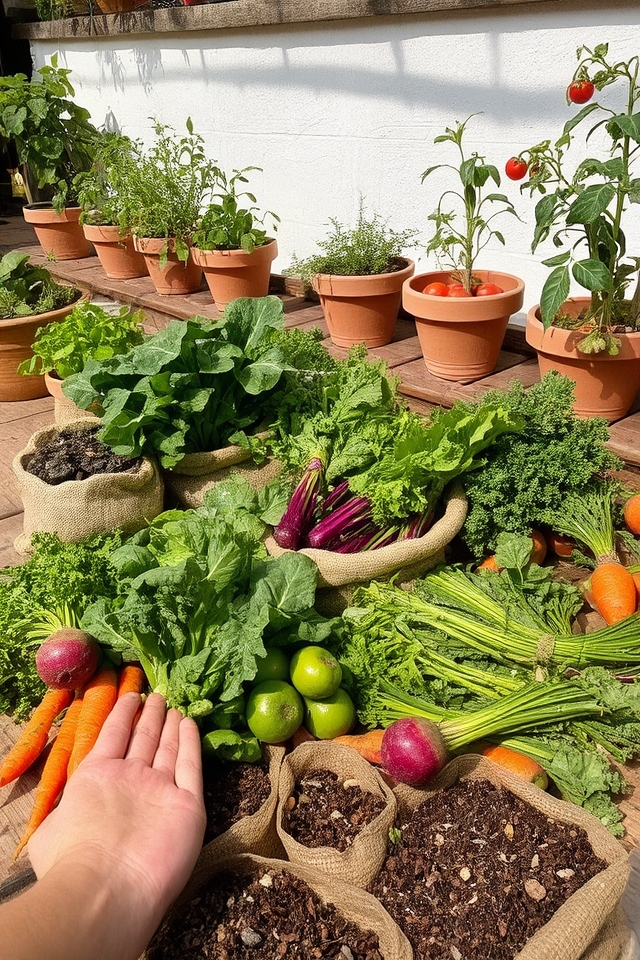
Fertilizing wisely is essential for the success of your terrace vegetable garden. Choose organic fertilizers like compost or well-rotted manure to enrich the soil without harming beneficial microorganisms. Apply fertilizers based on the specific needs of your plants; for example, leafy greens thrive with nitrogen, while root vegetables benefit from phosphorus. Always follow the recommended dosages and avoid over-fertilizing, as this can lead to nutrient imbalances and damage your plants. Regular monitoring will help you adjust your fertilization schedule as needed.
Keep Pests at Bay
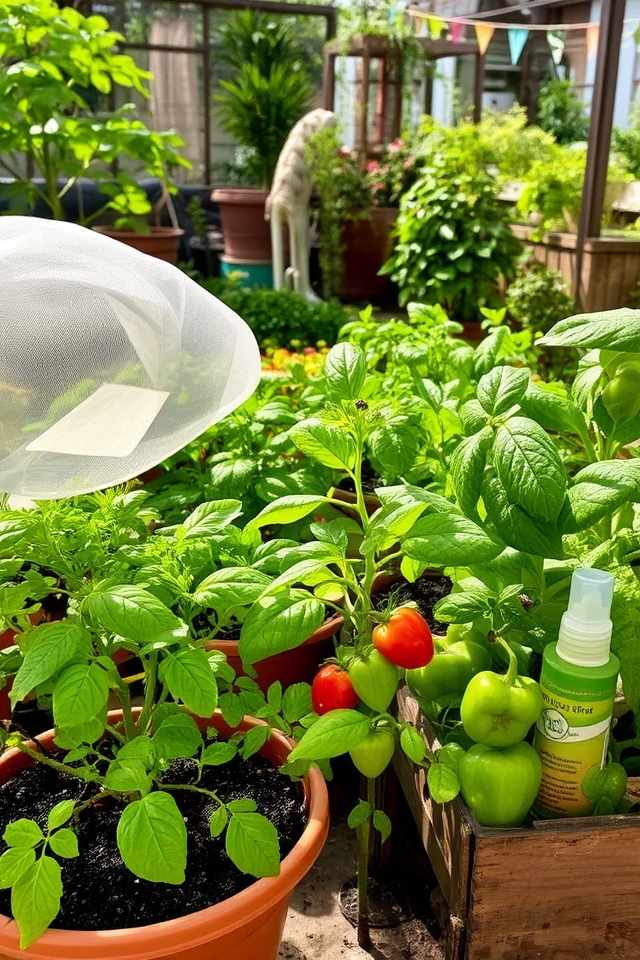
To keep pests at bay in your terrace vegetable garden, consider implementing a combination of natural deterrents and companion planting. Use barriers such as floating row covers or insect nets to physically block pests from reaching your plants. Additionally, introduce beneficial insects like ladybugs or lacewings, which prey on harmful pests. Regularly inspect your plants for signs of infestation and use organic sprays, like neem oil, to manage any outbreaks. Maintaining healthy soil and plants will also enhance their resilience against pests.
Prune and Train Your Plants
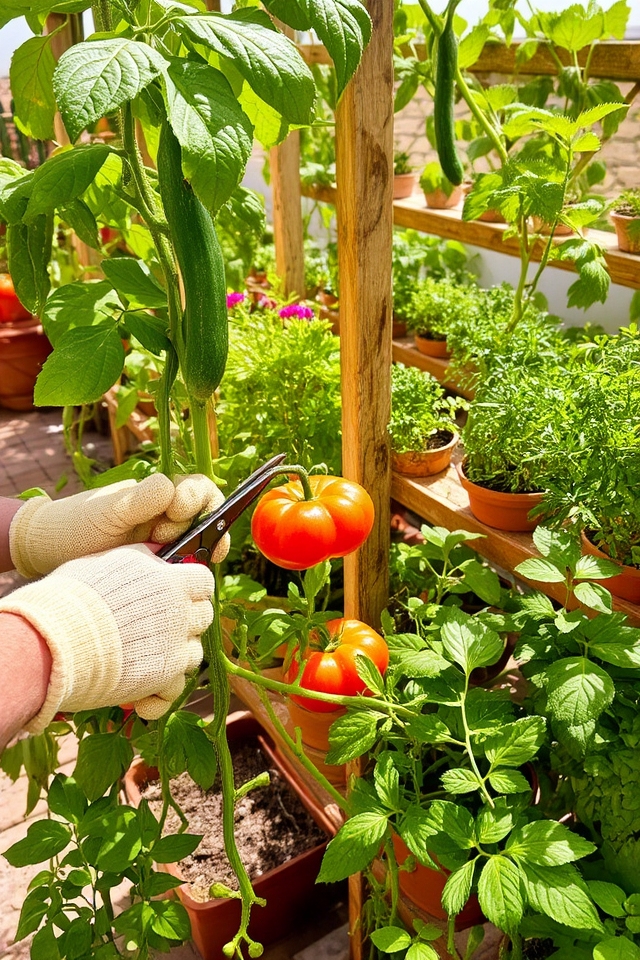
Pruning and training your plants is crucial for a productive terrace vegetable garden. Regularly trim dead or diseased leaves to encourage new growth and improve air circulation. Additionally, utilize trellises, stakes, or cages to support climbing varieties like tomatoes and cucumbers. This not only saves space but also guarantees the plants receive adequate sunlight. Properly managing your plants will lead to healthier harvests and a more organized garden environment.
Monitor Weather Conditions
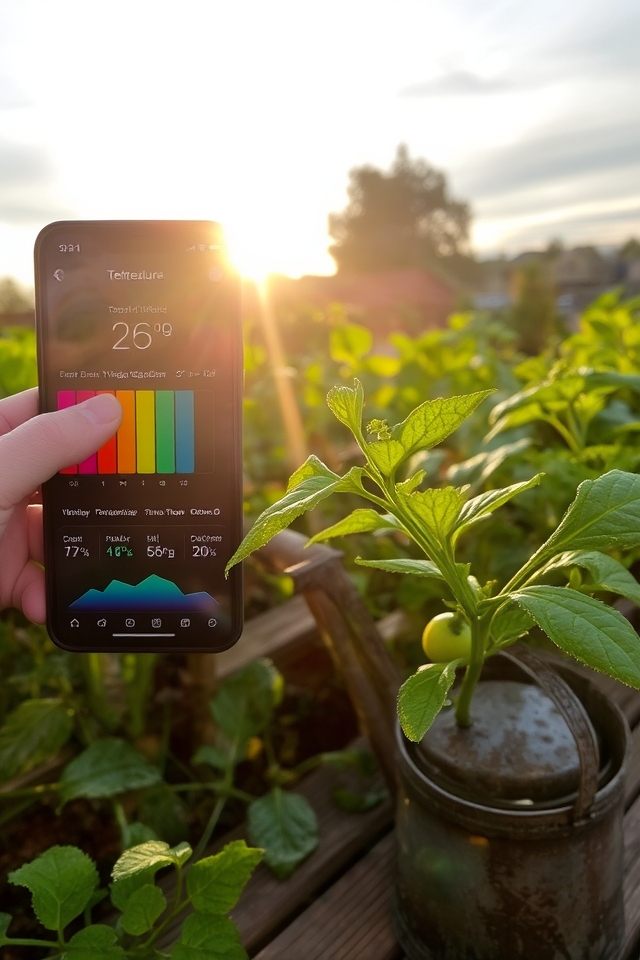
Monitoring weather conditions is essential for a successful terrace vegetable garden. Keep an eye on temperature fluctuations, precipitation levels, and wind patterns to guarantee ideal growth for your plants. Use a weather app or local forecasts to anticipate rainfall or extreme heat, which can affect watering schedules and plant health. By staying informed, you can make timely adjustments, such as providing shade during heatwaves or protecting plants from unexpected frost, ensuring a thriving garden.
Harvest Regularly
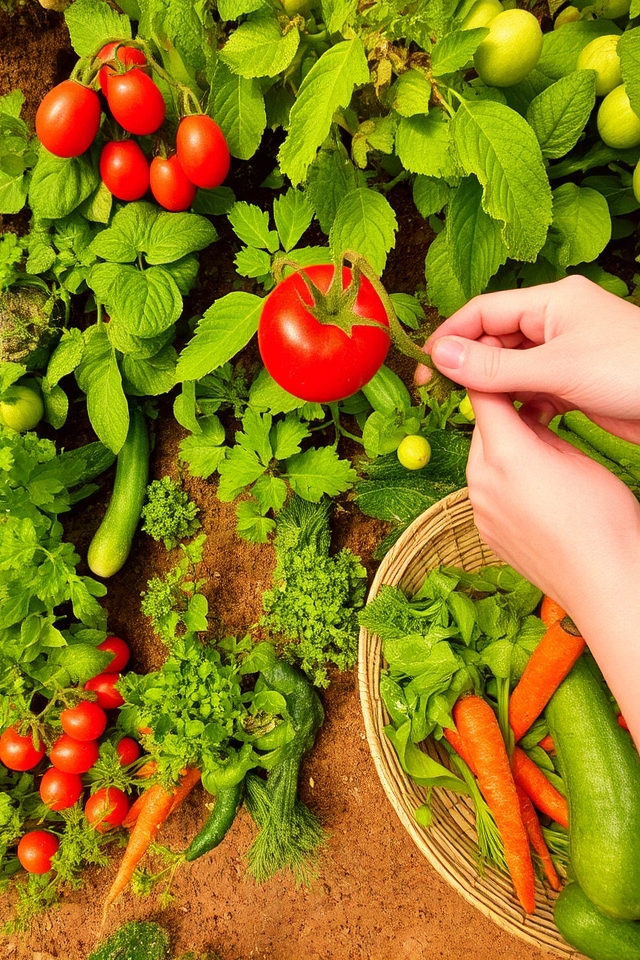
Harvesting regularly is crucial for maintaining a productive terrace vegetable garden. Frequent harvesting encourages plants to produce more, as it signals them to continue growing and flowering. Pick vegetables when they reach their peak ripeness for the best flavor and nutrition. Additionally, regular harvesting helps prevent overripening, which can lead to pest issues or disease. Utilizing this practice not only guarantees a steady supply of fresh produce but also keeps your garden thriving and healthy.
Rotate Crops Annually
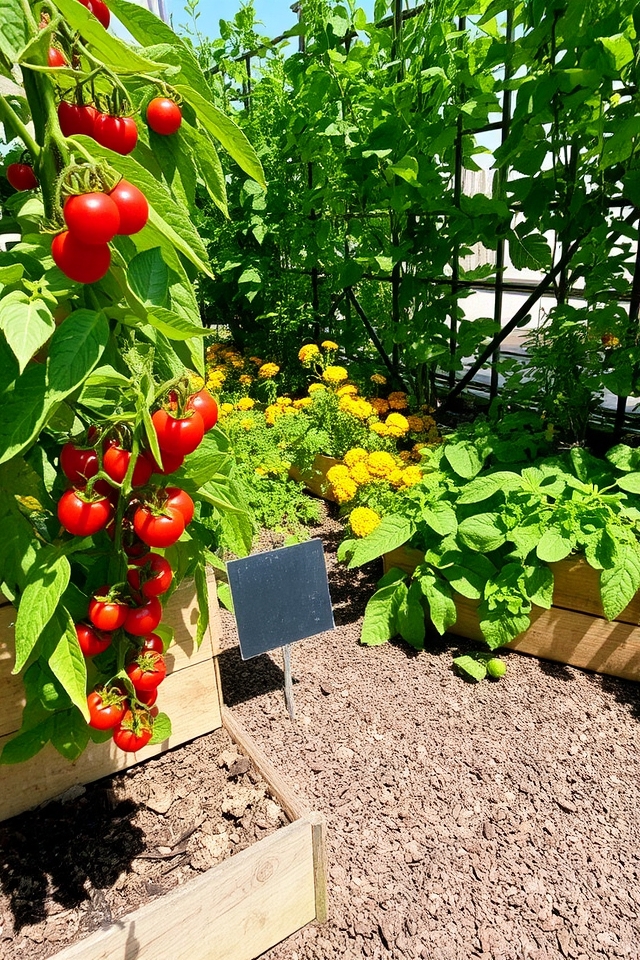
Rotating crops annually is a fundamental practice for maintaining soil health and reducing pest and disease issues in your terrace vegetable garden. By changing the location of specific plant families each year, you can help prevent soil nutrient depletion and disrupt pest life cycles. For instance, following heavy feeders like tomatoes with lighter feeders such as beans can promote soil balance. This rotation not only enhances plant growth but also contributes to a more sustainable gardening ecosystem.
Enjoy the Process!
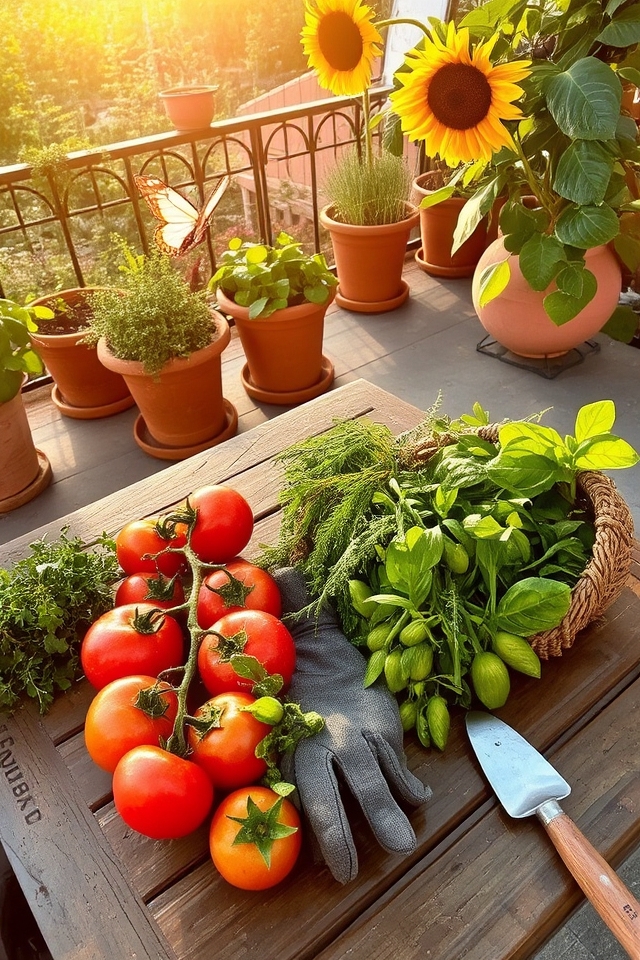
Gardening is not just about the end result; it’s about enjoying the journey. Embrace the joy of planting seeds, watching them grow, and nurturing your terrace vegetable garden. Spend time observing nature, experimenting with different plants, and learning from your successes and failures. Celebrate the little victories, whether it’s the first sprout emerging or a bountiful harvest. By focusing on the process, you’ll enrich your gardening experience and develop a deeper connection with your plants.
Conclusion
In your terrace vegetable garden, every seed planted is a promise of fresh produce and culinary delight. By following these 17 tips, you’re not just cultivating plants but nurturing a vibrant ecosystem that thrives on care and creativity. Embrace the journey, celebrating both the challenges and rewards that come with gardening. With each harvest, you’ll not only reap the fruits of your labor but also cultivate a deeper connection to nature and your food. Happy gardening!


